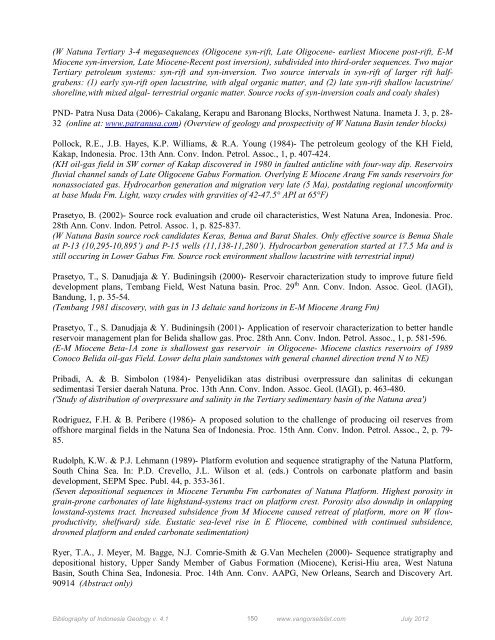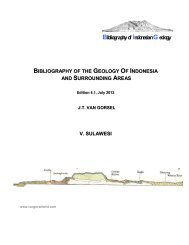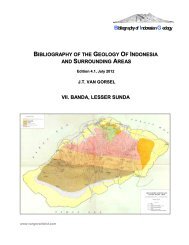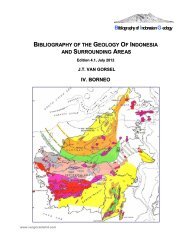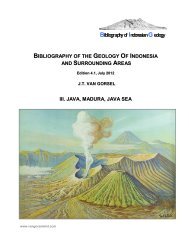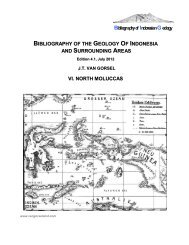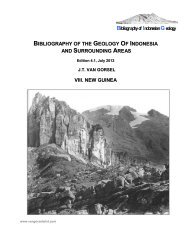Sumatra, Sunda Shelf, Natuna - Bibliography of Indonesia Geology
Sumatra, Sunda Shelf, Natuna - Bibliography of Indonesia Geology
Sumatra, Sunda Shelf, Natuna - Bibliography of Indonesia Geology
Create successful ePaper yourself
Turn your PDF publications into a flip-book with our unique Google optimized e-Paper software.
(W <strong>Natuna</strong> Tertiary 3-4 megasequences (Oligocene syn-rift, Late Oligocene- earliest Miocene post-rift, E-M<br />
Miocene syn-inversion, Late Miocene-Recent post inversion), subdivided into third-order sequences. Two major<br />
Tertiary petroleum systems: syn-rift and syn-inversion. Two source intervals in syn-rift <strong>of</strong> larger rift halfgrabens:<br />
(1) early syn-rift open lacustrine, with algal organic matter, and (2) late syn-rift shallow lacustrine/<br />
shoreline,with mixed algal- terrestrial organic matter. Source rocks <strong>of</strong> syn-inversion coals and coaly shales)<br />
PND- Patra Nusa Data (2006)- Cakalang, Kerapu and Baronang Blocks, Northwest <strong>Natuna</strong>. Inameta J. 3, p. 28-<br />
32 (online at: www.patranusa.com) (Overview <strong>of</strong> geology and prospectivity <strong>of</strong> W <strong>Natuna</strong> Basin tender blocks)<br />
Pollock, R.E., J.B. Hayes, K.P. Williams, & R.A. Young (1984)- The petroleum geology <strong>of</strong> the KH Field,<br />
Kakap, <strong>Indonesia</strong>. Proc. 13th Ann. Conv. Indon. Petrol. Assoc., 1, p. 407-424.<br />
(KH oil-gas field in SW corner <strong>of</strong> Kakap discovered in 1980 in faulted anticline with four-way dip. Reservoirs<br />
fluvial channel sands <strong>of</strong> Late Oligocene Gabus Formation. Overlying E Miocene Arang Fm sands reservoirs for<br />
nonassociated gas. Hydrocarbon generation and migration very late (5 Ma), postdating regional unconformity<br />
at base Muda Fm. Light, waxy crudes with gravities <strong>of</strong> 42-47.5° API at 65°F)<br />
Prasetyo, B. (2002)- Source rock evaluation and crude oil characteristics, West <strong>Natuna</strong> Area, <strong>Indonesia</strong>. Proc.<br />
28th Ann. Conv. Indon. Petrol. Assoc. 1, p. 825-837.<br />
(W <strong>Natuna</strong> Basin source rock candidates Keras, Benua and Barat Shales. Only effective source is Benua Shale<br />
at P-13 (10,295-10,895’) and P-15 wells (11,138-11,280’). Hydrocarbon generation started at 17.5 Ma and is<br />
still occuring in Lower Gabus Fm. Source rock environment shallow lacustrine with terrestrial input)<br />
Prasetyo, T., S. Danudjaja & Y. Budiningsih (2000)- Reservoir characterization study to improve future field<br />
development plans, Tembang Field, West <strong>Natuna</strong> basin. Proc. 29 th Ann. Conv. Indon. Assoc. Geol. (IAGI),<br />
Bandung, 1, p. 35-54.<br />
(Tembang 1981 discovery, with gas in 13 deltaic sand horizons in E-M Miocene Arang Fm)<br />
Prasetyo, T., S. Danudjaja & Y. Budiningsih (2001)- Application <strong>of</strong> reservoir characterization to better handle<br />
reservoir management plan for Belida shallow gas. Proc. 28th Ann. Conv. Indon. Petrol. Assoc., 1, p. 581-596.<br />
(E-M Miocene Beta-1A zone is shallowest gas reservoir in Oligocene- Miocene clastics reservoirs <strong>of</strong> 1989<br />
Conoco Belida oil-gas Field. Lower delta plain sandstones with general channel direction trend N to NE)<br />
Pribadi, A. & B. Simbolon (1984)- Penyelidikan atas distribusi overpressure dan salinitas di cekungan<br />
sedimentasi Tersier daerah <strong>Natuna</strong>. Proc. 13th Ann. Conv. Indon. Assoc. Geol. (IAGI), p. 463-480.<br />
('Study <strong>of</strong> distribution <strong>of</strong> overpressure and salinity in the Tertiary sedimentary basin <strong>of</strong> the <strong>Natuna</strong> area')<br />
Rodriguez, F.H. & B. Peribere (1986)- A proposed solution to the challenge <strong>of</strong> producing oil reserves from<br />
<strong>of</strong>fshore marginal fields in the <strong>Natuna</strong> Sea <strong>of</strong> <strong>Indonesia</strong>. Proc. 15th Ann. Conv. Indon. Petrol. Assoc., 2, p. 79-<br />
85.<br />
Rudolph, K.W. & P.J. Lehmann (1989)- Platform evolution and sequence stratigraphy <strong>of</strong> the <strong>Natuna</strong> Platform,<br />
South China Sea. In: P.D. Crevello, J.L. Wilson et al. (eds.) Controls on carbonate platform and basin<br />
development, SEPM Spec. Publ. 44, p. 353-361.<br />
(Seven depositional sequences in Miocene Terumbu Fm carbonates <strong>of</strong> <strong>Natuna</strong> Platform. Highest porosity in<br />
grain-prone carbonates <strong>of</strong> late highstand-systems tract on platform crest. Porosity also downdip in onlapping<br />
lowstand-systems tract. Increased subsidence from M Miocene caused retreat <strong>of</strong> platform, more on W (lowproductivity,<br />
shelfward) side. Eustatic sea-level rise in E Pliocene, combined with continued subsidence,<br />
drowned platform and ended carbonate sedimentation)<br />
Ryer, T.A., J. Meyer, M. Bagge, N.J. Comrie-Smith & G.Van Mechelen (2000)- Sequence stratigraphy and<br />
depositional history, Upper Sandy Member <strong>of</strong> Gabus Formation (Miocene), Kerisi-Hiu area, West <strong>Natuna</strong><br />
Basin, South China Sea, <strong>Indonesia</strong>. Proc. 14th Ann. Conv. AAPG, New Orleans, Search and Discovery Art.<br />
90914 (Abstract only)<br />
<strong>Bibliography</strong> <strong>of</strong> <strong>Indonesia</strong> <strong>Geology</strong> v. 4.1 150 www.vangorselslist.com July 2012


